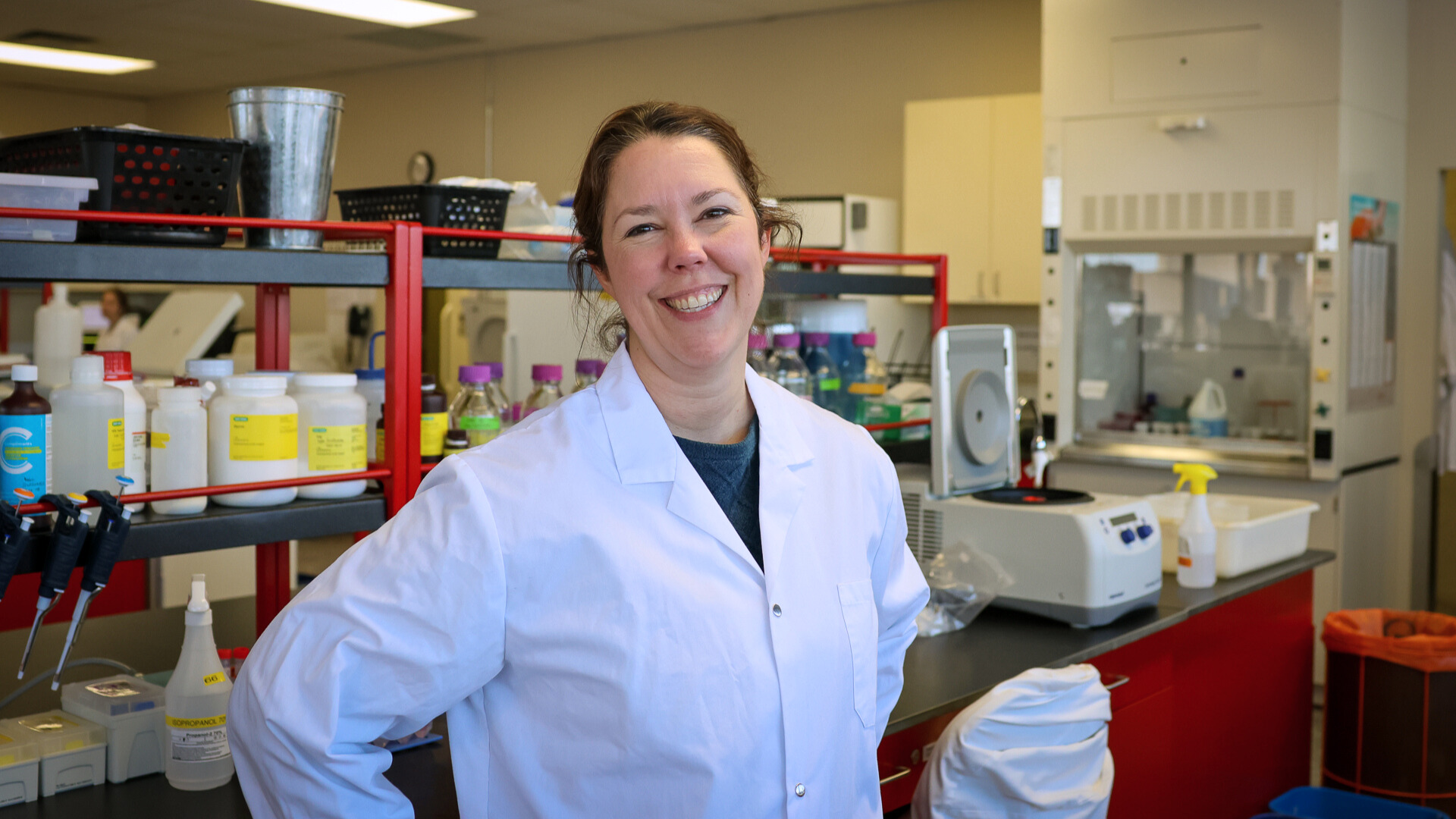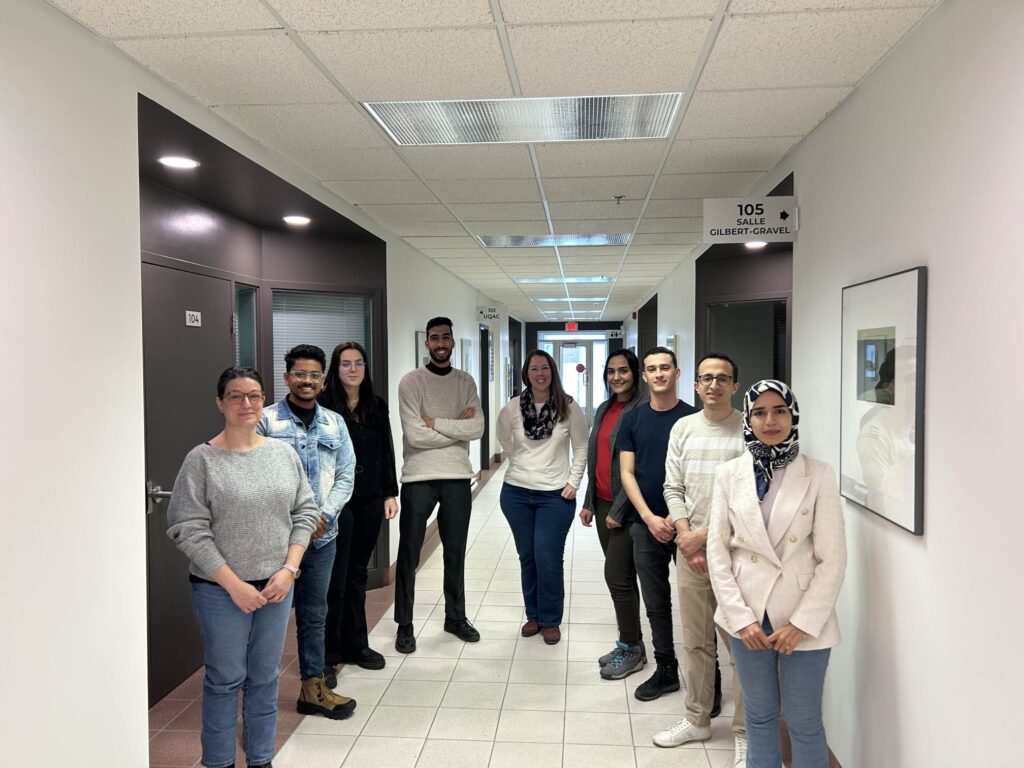- Overview
- Research
The series “Tour d’horizon en trois questions” highlights research in all its forms and takes an informed look at current events.

Marie-Claude Sincennes from the INRS-UQAC Joint Research Unit, in her lab at UQAC. Photo : UQAC
INRS professor Marie-Claude Sincennes has been studying rare diseases for the past 10 years and is interested in the infinitely small. She is one of a handful of experts around the world studying muscle stem cells to identify better therapeutic targets for neuromuscular diseases.
She joined the INRS-UQAC Joint Research Unit (UMR) in Sustainable Health in 2022, where she works in collaboration with other scientists and local partners. A synergy of expertise necessary for progress in a field where much remains to be discovered.
Professor Sincennes answers our questions as part of Rare Disease Day, which aims to raise awareness, highlight the importance of research and mobilize increased support for those affected by these understudied diseases.
A disease is considered rare when it affects fewer than 1 in 2,000 people
Source : RQMO
More than 7,000 rare diseases have been identified around the world. In Quebec, it is estimated that nearly 500,000 people have or are carriers of a rare disease. You’ve chosen to research some of these diseases, and specifically, the role of genetics. Can you tell us more?
What I prefer about scientific research is discovering the function of genes that are rarely studied, or discovering new functions for genes that are already known.
This is what I did during my PhD in molecular biology while studying a gene involved in leukemia. I discovered that this gene, in addition to its well-known and well-characterized function, could perform several different functions that had not yet been investigated. I found this project really exciting, but it took me a few years to realize that it was precisely discovering new functions for certain genes that I found so stimulating.
During my postdoctoral training, I developed expertise in muscle stem cells and muscle tissue regeneration.
Stem cells are very difficult to study, first because they are rare, and second because there are very few in vitro models that can accurately reflect their biology. We are therefore very few scientists in the world who are interested in this particular type of cells, which are nevertheless of paramount importance because they control the regeneration of the muscle during an injury or in certain diseases associated with muscle loss.
Obviously, I wanted to use this expertise to study the function of genes involved in rare and understudied neuromuscular diseases such as rhabdomyosarcoma, muscular dystrophies or certain myopathies.
My laboratory is located at the Université du Québec à Chicoutimi (UQAC) within the UMR INRS-UQAC, in the heart of Saguenay-Lac-St-Jean, a region known for its high prevalence of rare diseases because of its history. Indeed, migratory events, coupled with a high fertility rate and the geographical isolation of the region, make its genetic diversity more restricted than in major centres.
I am very proud to contribute, with my team, to studying certain diseases associated with muscle tissue that are more prevalent in my new home region, such as oculopharyngeal muscular dystrophy.
Collaboration is at the heart of research success. In your opinion, is this even more true for research on diseases of which we know practically nothing? What are the innovative approaches currently used in rare disease research?
As the saying goes, there is strength in unity, and I think that’s even more true in the context of rare diseases. I’m collaborating with my colleagues at the UMR, including Jean Legault from UQAC, and Charles Gauthier and Amadou Barry from INRS, on a project that studies rhabdomyosarcoma, a rare form of childhood cancer. We want to understand the role of the genes that are mutated in this type of cancer and identify new molecules that affect the survival or proliferation of rhabdomyosarcoma cells, in order to develop future therapeutic targets.
My team is also developing new collaborations with Catherine Laprise of UQAC on a rare disease called epidermolysis bullosa simplex, and also with researchers from the Centre hospitalier de l’Université de Montréal and UQAM on a rare myopathy — so rare it doesn’t have a name yet!
Beyond innovative technologies, I believe that interdisciplinarity is really the key to making significant advances in the field of rare diseases. The Saguenay region obviously does not have a critical mass of researchers in rare diseases, which is why collaboration is all the more important. Initiatives such as the Intersectoral Centre for Sustainable Health (CISD) and the Interdisciplinary Neuromuscular Disease Research Group (GRIMN) demonstrate how Saguenay is doing well by drawing on the diverse expertise of the region’s specialists. While I bring expertise in molecular and cellular biology, GRIMN has been working for several years with people with rare diseases in Saguenay, and it brings an extremely enriching perspective to my research program.
Beyond collaboration, my team of doctoral and master’s students and three interns from different places contribute to enriching exchanges and deepening knowledge. A new generation of researchers ready to meet major challenges.

This is an area of research that has long been considered underfunded and neglected. Recently, initiatives have emerged, and Quebec has even adopted a Rare Diseases Action Plan 2023-2031. Do you feel that things are changing? What motivates you to continue your work in this area?
My laboratory is entirely dedicated to the study of rare diseases, with particular interest in diseases associated with muscle tissue. I am therefore convinced that our contribution to this area will provide a better understanding of the biological mechanisms that are compromised in neuromuscular diseases, and will improve the quality of life of people living with these diseases. This is what motivates me to continue along this path.
I am pleased to see that our decision-makers have chosen to invest in this specific area. Since rare diseases, and especially the genes associated with them, are seldom studied, each discovery represents a significant advance in the field, or even proves beneficial for more common diseases.
Indeed, discoveries around a particular disease can influence our understanding of other pathologies that develop with similar mechanisms. Conversely, some drugs that have been developed for common diseases deserve to be tested for their effectiveness for certain types of rare diseases. This is one of the aspects that our INRS-UQAC Joint Research Unit is studying.
There is much to be done and still a lot of unresolved issues to help those affected. This is what motivates me as a researcher, mother and citizen.



